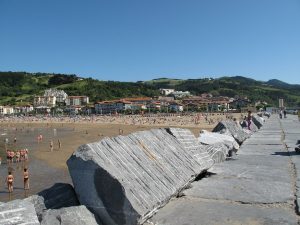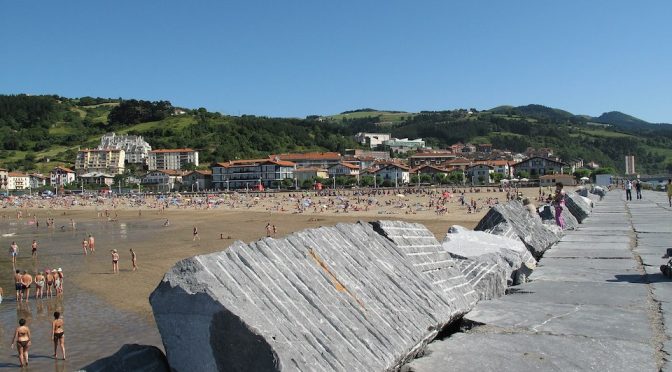From Leiketio, we left Bizkaia and entered Deba. I’ve driven through Deba a few times now, and am always struck with the seeming dichotomy of the town. Known for its marvelous beach, the west bank of the Deba River is instead dotted with abandoned industrial buildings. Coming from the west and passing by these seemingly derelict buildings, it is hard to see the beauty of the beach. However, the town itself is charming. The beach is huge and the center of town is marked by many small shops and restaurants. Separating the two is a large park filled with trees, a somewhat unique feature for these Basque coastal towns.

- Deba sits at the mouth of the river Deba, where it flows into the Atlantic Ocean. The town takes its name from the river. It is distinguished by the large beach which, today, attracts a large number of visitors.
- In fact, when, in the middle of the 19th century the town was connected to the rail lines, it became an attraction for people far and wide, particularly from Madrid. It also became a key place for the people of Eibar and Ermua. Many people built second homes on the beach front. Today, tourism accounts for 50% of the jobs in the town, a shift from the earlier focus on fishing and ship building. Deba’s population is barely over 5,000 people, but that number swells in the summer as vacationers flock to the beach.
- The region around Deba has been inhabited by humans since at least Paleolithic times (some 12,000 years ago). Caves discovered in the 1900s in the surrounding mountains of Ermittia and Arbil attest to these ancient humans. In 1969, the Ekain cave was discovered which contains a Paleolithic temple decorated with paintings of horses, bison, goats, deer, bears and fish in black. This cave, along with several others in the Basque Country, was declared a World Heritage Site in 2008. In total, there are some 50 prehistoric caves and sites in the region.
- As a town, Deba’s history goes back to 1179 when one of its neighborhoods, Iziar, was mentioned in the treaty signed on April 15, 1179 between Alfonso VIII of Castile and Sancho the Wise of Nafarroa. However, the founding of the town was in 1343. In 1294, the town had been given permission to begin construction, in the region of Iziar. The towns people found the location less than ideal and asked to be closer to the sea. This request was granted in 1343. The first municipal ordinances were adopted in 1394.
- Along with its neighbors – Mutriku to the west and Zumaia to the east – Deba is part of the Basque Coast Geopark. The flysch of Zumaia, shared along the Basque coast with Deba, are part of the scenic landforms that characterize the region. The unique landscape is also characterized by limestone and the nearby Lastur quarry is known for its stone, including the Gris Deba, or Deba Grey, marble, named for Deba.
Primary sources: Arozamena Ayala, Ainhoa; Cendoya Echániz, Ignacio. DEBA. Auñamendi Encyclopedia. Available at: https://aunamendi.eusko-ikaskuntza.eus/en/deba/ar-48401/; Deva (Guipúzcoa), Wikipedia
Discover more from Buber's Basque Page
Subscribe to get the latest posts sent to your email.


